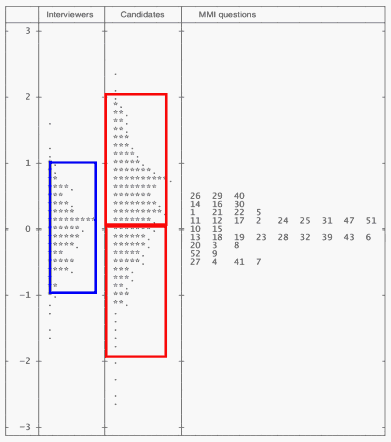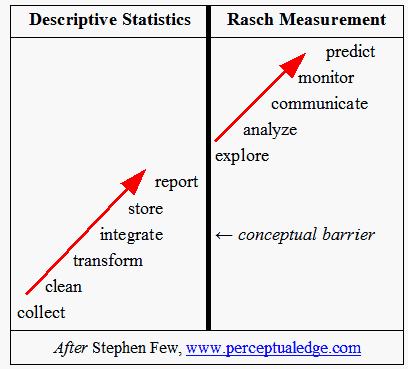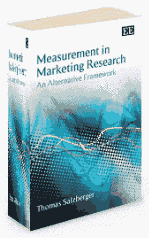
Is the Partial Credit Model a Rasch Model?
Question: How is it possible for the Andrich Rating-Scale version of the Rasch polytomous model to satisfy the requirements of statistical sufficiency of person and item raw scores and separability of model parameters, but not the Masters Partial-Credit version?
Answer: It isn't. Every parameter of a Rasch model (including the Partial Credit Model) has a matching raw score, its "sufficient statistic". This leads to parameter separability. Of course, those raw scores (and the observations summed to make them) are not independent, because every observation manifests more than one parameter. In the dichotomous model, every observation contributes to one person and one item. In most Rasch polytomous models, every observation contributes to one person, one item and one ordinal category.
Gerhard Fischer has a chapter in the book "Rasch Models" in which he derives Rasch polytomous models from sufficiency. His example is a multidimensional form of the Partial Credit Model. He also derives the Partial Credit Model from other Rasch-related criteria.
Should Hypothesis Tests be Rejected?
"Rigorous mathematical methods have secured science's fidelity to fact and conferred a timeless reliability to its findings. ... But in practice, widespread misuse of statistical methods makes science more like a crapshoot. It's science's dirtiest secret: The "scientific method" of testing hypotheses by statistical analysis stands on a flimsy foundation. Statistical tests are supposed to guide scientists in judging whether an experimental result reflects some real effect or is merely a random fluke, but the standard methods mix mutually inconsistent philosophies and offer no meaningful basis for making such decisions. Even when performed correctly, statistical tests are widely misunderstood and frequently misinterpreted. As a result, countless conclusions in the scientific literature are erroneous, and tests of medical dangers or treatments are often contradictory and confusing."
Tom Siegfreid, Science News, 3/27/2010, 177:7, 26.
www.sciencenews.org/view/feature/id/57091/
Figure 2 in "Should candidate scores be adjusted for interviewer stringency or leniency in the multiple mini-interview?" by Chris Roberts, Imogene Rothnie, Nathan Zoanetti & Jim Crossley, Medical Education 2010: 44: 690-698
Notice that the practical logit range of the interviewers (raters, my blue box) is about half that of the candidates (my red boxes). So that:
smartest candidate + most severe rater ≈ least smart candidate + most lenient rater
This was first noticed by Francis Ysidro Edgeworth around 1890, but 120 years later, Examination Boards continue to rely on the "luck of the draw" (as stated in Shavelson & Webb, Generalizability Theory, 1991, p.8).
 |
Quality Control and Waste
Does Rasch quality-control fit-analysis waste items? Quality-control always generates "waste" along the road to creating good products, but there are not many car-drivers who would consider that binning (rejecting) misfitting tires is a waste. Nor many soldiers who would consider that binning misfitting ammunition is a waste.
W.E. Deming used to point out that proper quality-control reduces waste overall because the manufacturing process is improved. Using 2-PL and 3-PL facilitates sloppy item-writing, poor test-administration procedures and inadequate conceptualization of the latent variable. Perhaps this attitude toward psychometric "waste" is yet another reason why advances in the social sciences lag so far behind those in the physical sciences.
Descriptive Statistics vs. Rasch Measurement
After Stephen Few, www.perceptualedge.com
 |
Rasch Mixture Models
Rasch Mixture (or Mixed) models (Rost, 1990) combine Latent Class Analysis (LCA) with Rasch analysis. LCA is based on Lazarsfeld PF, Henry NW. Latent structure analysis. Boston: Houghton Mifflin, 1968. This technique identifies classes or types within a sample, and then estimates each sample-member's probability of belonging to each class. Rasch models estimate each sample-member's ability within each class, and each item's difficulty for each class.
In order for the probabilities, abilities and difficulties to be uniquely estimable, the Mixture model analysis must be constrained. Typical constraints include: each person's ability (or each item's difficulty) is the same across classes, also the person abilities (and/or the item difficulties) are distributed normally within classes.
Software for estimating Rasch Mixture models includes WINMIRA and Latent GOLD.
Rost, Jürgen. (1990). Rasch models in latent classes: An integration of two approaches to item analysis. Applied Psychological Measurement, 14, 271-282.
Figure 2. Map of the performance of a student. In G. Prieto and A. R. Delgado (2003). Análisis de un test mediante el modelo de Rasch. Psicothema, 15:1, 94-100
 |
CAT Requires a Change in Thinking
"The condition-specific CATs (Computer-Adaptive Tests) were received well by clinicians and patients with respect to limited time to complete, but the [we] continued to receive calls related to changing of items from one CAT administration to another over the time of rehabilitation. Researchers considered these comments supportive of the CAT functioning properly, administering more difficult items to higher functioning patients as they improve during rehabilitation, but clinicians wanted to serially track the patient's improvement per question, which the CATs did not permit." (p. 296)
Hart D. et al. (2010). Implementing Computerized Adaptive Tests in Routine Clinical Practice: Experience Implementing CATs. Journal of Applied Measurement, 11:3, 288-303.
CAT requires a change of perspective from the details of the protocol to the meaning of the measures on the latent variable.
Online Educational Research Journal www.oerj.org/View?action=frontpage
"OERJ is an entirely internet-based educational research journal. It is available to anyone who can access the web and all articles can be read and downloaded online. Anybody can submit articles as well as comment on and rate articles. Submissions are published immediately provided certain rules are followed. The language of the journal is English."
Journal of Applied Measurement Vol. 11, No. 2 Summer 2010
Using Item Response Modeling Methods to Test Theory Related to Human Performance. Diane D. Allen, 99-111
From Model to Measurement with Dichotomous Items. Don Burdick, A. Jackson Stenner, and Andrew Kyngdon, 112-121
Using Guttman's Mapping Sentences and Many Facet Rasch Measurement Theory to Develop an Instrument that Examines the Grading Philosophies of Teachers. Jennifer Randall and George Engelhard, Jr., 122-141
Development of Scales Relating to Professional Development of Community College Administrators. Edward W. Wolfe and Kim E. Van Der Linden, 142-157
Comparing Décalage and Development with Cognitive Developmental Tests. Trevor Bond, 158-171
Reliability of Performance Examinations: Revisited. Mary E. Lunz and John M. Linacre, 172-181
Understanding Rasch Measurement: Equating Designs and Procedures Used in Rasch Scaling. Gary Skaggs and Edward W. Wolfe, 182-195
Richard M. Smith, Editor
JAM web site: www.jampress.org
JAM library recommendation form
Journal of Applied Measurement Vol. 11, No. 3 Fall 2010
Special Issue:
The Improving Efficiency in Outcome Measurement
Preface, Improving Efficiency in Outcome Measurement. Allen W. Heinemann, 196
Foreword, Emergence of Efficiency in Health Outcome Measurement. Nikolaus Bezruczko, Guest Editor, 197-213
Measuring One Variable at a Time: The Wright Way. Ed Bouchard, 214-229
Rasch-Derived Latent Trait Measurement of Outcomes: Insightful Use Leads to Precision Case Management and Evidence-Based Practices in Functional Healthcare. Carl V. Granger, Marsha Carlin, John M. Linacre, Ronald Mead, Paulette Niewczyk, A. Jackson Stenner, and Luigi Tesio, 230-243
Generally Objective Measurement of Human Temperature and Reading Ability: Some Corollaries. A. Jackson Stenner and Mark Stone, 244-252
A Clinically Meaningful Theory of Outcome Measures in Rehabilitation Medicine. Robert W. Massof, 253-270
Embedding Measurement within Existing Computerized Data Systems: Scaling Clinical Laboratory and Medical Records Heart Failure Data to Predict ICU Admission. William P. Fisher, Jr. and Elizabeth C. Burton, 271-287
Implementing Computerized Adaptive Tests in Routine Clinical Practice: Experience Implementing CATs. Dennis L. Hart, Daniel Deutscher, Mark W. Werneke, Judy Holder, and Ying-Chih Wang, 288-303
The Use of PROMIS and Assessment Center to Deliver Patient-Reported Outcome Measures in Clinical Research. Richard C. Gershon, Nan Rothrock, Rachel Hanrahan, Michael Bass, and David Cella, 304-314
Opportunities for CAT Applications in Medical Rehabilitation: Development of Targeted Item Banks. Pamela A. Kisala and David S. Tulsky, 315-330
Postscript, Emergence of Efficiency in Health Outcomes Measurement. Karon F. Cook, 331-336
Richard M. Smith, Editor
JAM web site: www.jampress.org
JAM library recommendation form
Measurement In Marketing Research
An Alternative Framework
Thomas Salzberger analyses current measurement approaches in terms of their compliance with the scientific requirements of measurement. He reaches the conclusion that the predominantly applied practices, to a varying extent, suffer from substantial shortcomings, and suggests an alternative framework of measurement based on the philosophy of Rasch modeling. In the Rasch model great importance is attached to the mathematical principles of measurements, which take precedence over 'flexibility' in terms of accommodating idiosyncrasies of the data. The Rasch model promises to narrow the gap between the quality of measurement in the natural sciences and in the social sciences.
The future of measurement in marketing is about to be set. This book aims to raise researchers' awareness of measurement issues and to contribute to a transfer of knowledge from psychometrics into marketing research.
Book published by Edward Elgar Publishing, 2009.
 |
Benjamin D. Wright in Wikipedia
Please contribute your knowledge of Ben Wright to:
http://en.wikipedia.org/wiki/Benjamin_Drake_Wright
Courtesy of William P. Fisher, Jr. and Edward Bouchard.
Notes and Quotes, ... Rasch Measurement Transactions, 2010, 24:3 passim
| Forum | Rasch Measurement Forum to discuss any Rasch-related topic |
Go to Top of Page
Go to index of all Rasch Measurement Transactions
AERA members: Join the Rasch Measurement SIG and receive the printed version of RMT
Some back issues of RMT are available as bound volumes
Subscribe to Journal of Applied Measurement
Go to Institute for Objective Measurement Home Page. The Rasch Measurement SIG (AERA) thanks the Institute for Objective Measurement for inviting the publication of Rasch Measurement Transactions on the Institute's website, www.rasch.org.
| Coming Rasch-related Events | |
|---|---|
| Jan. 16 - Feb. 13, 2025, Fri.-Fri. | On-line workshop: Rasch Measurement - Core Topics (E. Smith, Winsteps), www.statistics.com |
| Apr. 8 - Apr. 11, 2026, Wed.-Sat. | National Council for Measurement in Education - Los Angeles, CA, ncme.org/events/2026-annual-meeting |
| Apr. 8 - Apr. 12, 2026, Wed.-Sun. | American Educational Research Association - Los Angeles, CA, www.aera.net/AERA2026 |
| May. 15 - June 12, 2026, Fri.-Fri. | On-line workshop: Rasch Measurement - Core Topics (E. Smith, Winsteps), www.statistics.com |
| June 19 - July 25, 2026, Fri.-Sat. | On-line workshop: Rasch Measurement - Further Topics (E. Smith, Winsteps), www.statistics.com |
The URL of this page is www.rasch.org/rmt/rmt243h.htm
Website: www.rasch.org/rmt/contents.htm